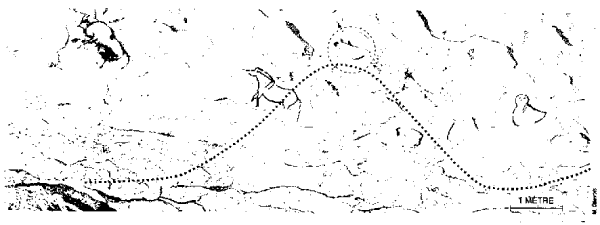 |
Science Frontiers ONLINE No. 123: May-Jun 1999 |
|
|
Caves As Musical Instruments
In past issues of SF, we have reported how some ancient rock art was intentionally painted on rock faces so that echos, as from a handclap, would not only be unusually loud but have some relation to the painting, as in the clatter of hooves. (SF#86) In a similar vein, some manmade chambers, such as New Grange (3,500 B.C.) were configured to enhance the subjective effects of ritual chanting. (SF#102)
A fascinating article in Pour la Science, has described how ancient paintings in some of Europe's famous decorated caves were placed where sound resonated. To illustrate, examine the accompanying illustration of the north wall of the Jeannel Gallery of Portel Cave, in Arlege. The long, looping dotted line indicates the amplitude of resonating sound at a frequency of 95 Hertz, as the long gallery behaves like a giant wind instrument. The peak occurs smack in the center of the decorated area. At the peak, in the dotted circle, there is a rocky projection in the shape of a (hard-to-see) feline head. On the opposite wall (not shown), the same peak coincides with an ocher circle that dominates a meter-long decorated panel.
(Dauvois, Michael, et al; "Son et Musique au Paleolithique," Pour la Science, p. 52, no. 253, November 1998. Cr. C. Mauge.)
Comment. Modern humans are also cognizant of acoustical effects, as in the design of auditoriums, churches, whispering galleries, etc.
 North Wall of La Galerie Jeannel. The dotted curve indicates standing wave amplitude at 95 Hertz. |